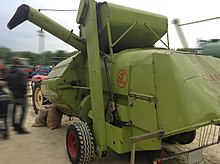Claas Super Junior
| Claas Brothers Maschinenfabrik | |
|---|---|

Claas Super-Junior at the Leipzig autumn fair in 1954 |
|
| Super junior | |
| Manufacturer: | Claas |
| Sales designation: |
Super-Junior Claas-Junior Claas-Junior-Automatic |
| Production period: | 1953-1969 |
| Engines: |
VW Typ 122 , ( Otto, 1192 cm 3 , 17 kW ) |
| Length: | 6150 mm |
| Width: | 2900 mm |
| Height: | 2850 mm |
| Standard tires: | 10-15 AM |
| Separation system: | Vibrating shaker |
| Threshing system: | Tangential |
| Cutting width: | 1.65 m |
| Threshed material unloading: |
Initially: from the sorting cylinder into sacks later: from the grain tank with the unloading screw |
| Grain tank volume: | 1.1 m 3 |
| Dimensions: | 1950 kg |
| Previous model: | none |
| Successor: | none |
The Super-Junior , also known as Claas-Junior , is a trailed straw walker combine harvester from Claas . It is the smaller equivalent of the Super , with which it shares the technology of the transverse longitudinal flow process. Production started in 1953, and from 1958 the junior automatic with hydraulic controls was offered. The last super junior was produced in 1969. Its hourly output should be an average of 1250 kg of grain during the combine harvest.
technology

The Super-Junior is a small combine harvester that works according to the cross-longitudinal flow method: the grain is threshed across the direction of travel and fed along the residual grain separation system. In addition to combine threshing, it is also suitable for swath threshing , crouch threshing and standing threshing . When harvesting, the Super-Junior is pulled by a tractor; it is designed for tractors with an engine output of 25 HP (approx. 18.5 kW). The tractor drives the cutting unit, the threshing unit and the residual grain separation system of the thresher via the PTO shaft . Claas also offered the Super-Junior with a type 122 built-on petrol engine from VW , which generates 23 hp (approx. 17 kW) from a displacement of 1.2 l. The VW engine can either drive the thresher alone or be supported by the tractor's PTO shaft. If the VW engine is installed, a tractor with 15 HP (approx. 11 kW) is sufficient for the operation of the Super Junior, for standing threshing a tractor with 12 kW engine power can also be used without an auxiliary engine.
The cutting unit with a width of 1650 mm of the Super-Junior is attached to the front right and runs next to the thresher, so the pulling tractor and the thresher do not drive through the grain to be harvested. It has rigid stalk dividers, rotating stalk dividers were also available on request. A large, six-part reel and six crop lifters ensure that the grain stands straight when it is cut and falls cleanly backwards onto the conveyor belt that transports the grain into the threshing drum. The height of the cutting unit can be adjusted mechanically. In the Super Automatic, a hydraulically height-adjustable cutting unit was installed as standard, which also has a spring-tine reel. A pick-up device was available for the Super-Junior for swath threshing. To transport the thresher, the cutting unit is folded up by approx. 80 °.
The threshing drum, with a diameter of 450 mm and a width of 1250 mm, is built into the Super-Junior lengthways front left and turns clockwise (viewed from the rear). The threshed material is fed in at an angle from below and tangentially. Six beater bars in the threshing drum drive the grain out of the ears. The straw is thrown from the threshing drum up onto the vibrating shaker, which separates the residual grain. The grain is cleaned by an adjustable upper sieve with an additional interchangeable lower sieve (area of each sieve approx. 0.8 m 2 ), the necessary wind is generated by a barrel blower. With the Super-Junior, the distance between the concave and the threshing drum, the so-called threshing gap, cannot be adjusted during operation. Threshed material that has not yet been threshed is returned to the threshing drum with the returns.
The pre-cleaned grain is conveyed with an elevator to the roof of the thresher to the sorting cylinder, where it is sorted into three quality levels and filled into sacks by a machine operator using a bagging device . The bagging stand was enlarged in the course of production so that it can transport around three to five full sacks before they have to be unloaded. There is no unloading chute. In the further course of production, the bagging stand was replaced by a grain tank that holds approx. 11 hl of grain. The chaff can be collected and also bagged if desired. In early machines, the straw is pressed by a built-in straw press with a channel width of 1000 mm (optionally 800 mm) into straw bundles with a weight between 8 kg and 15 kg and either single or double tied. The straw press was later omitted.
Remarks
- ↑ Claas mentions "15 HP or 12 kW"
swell
- Claas "Junior" 5½ . Prospectus, 1956
- Claas Junior Automatic . Prospectus, 1960s (French)
literature
- Jürgen Hummel, Alexander Oertle, Jan Sternberg, Peter Felser: Combine harvesters: history and technology . wk & f Kommunikation, Kempten 2008, ISBN 978-3-89880-417-2 , p. 34 .
